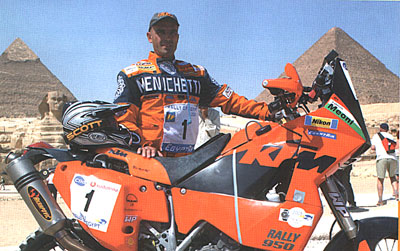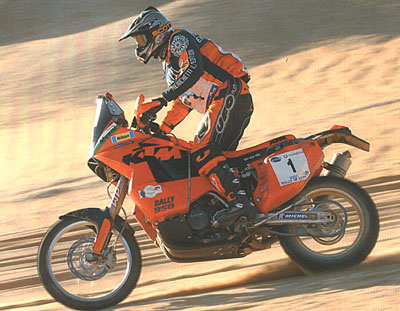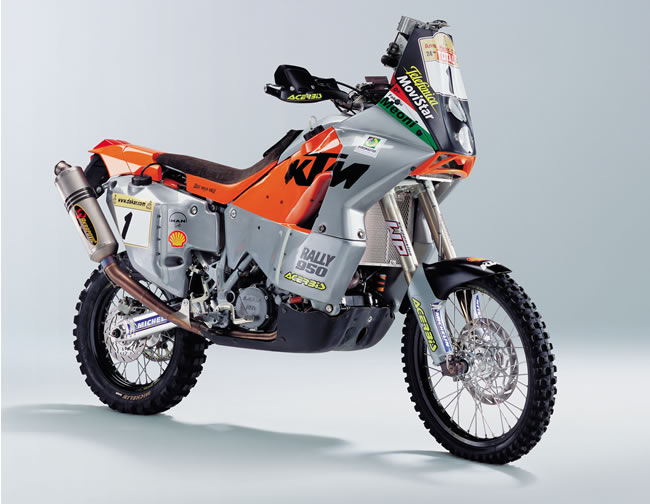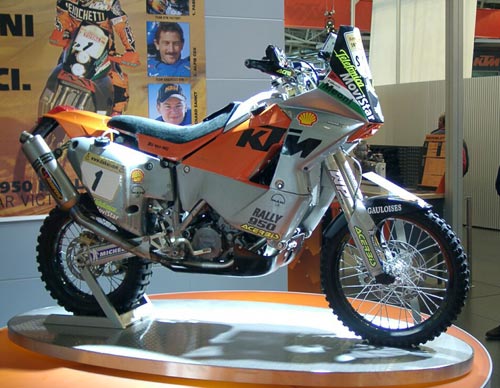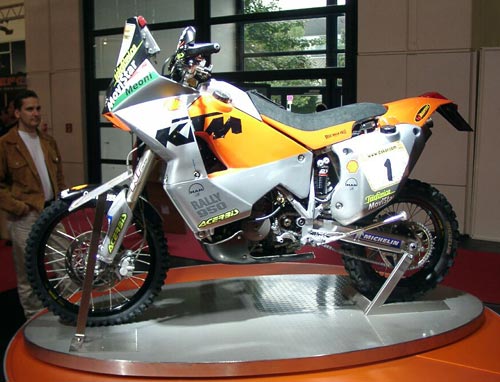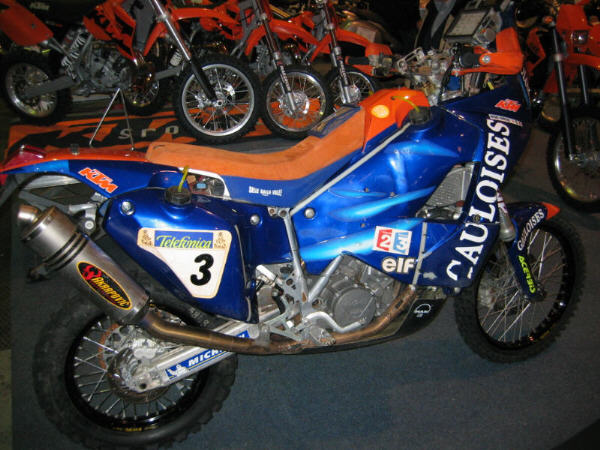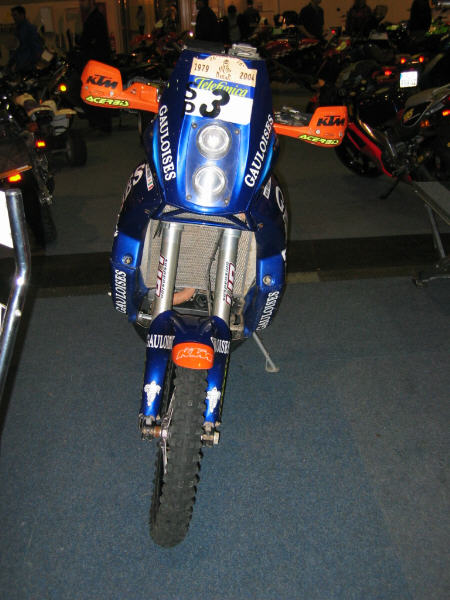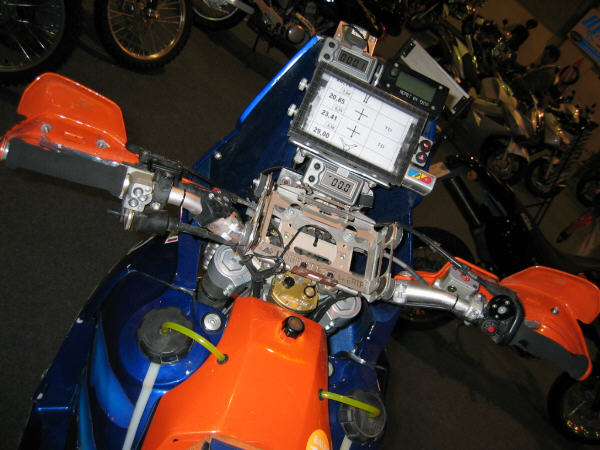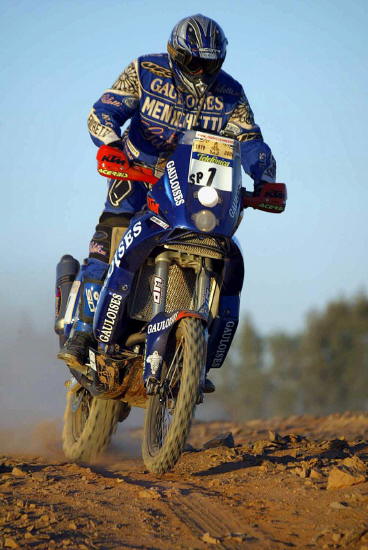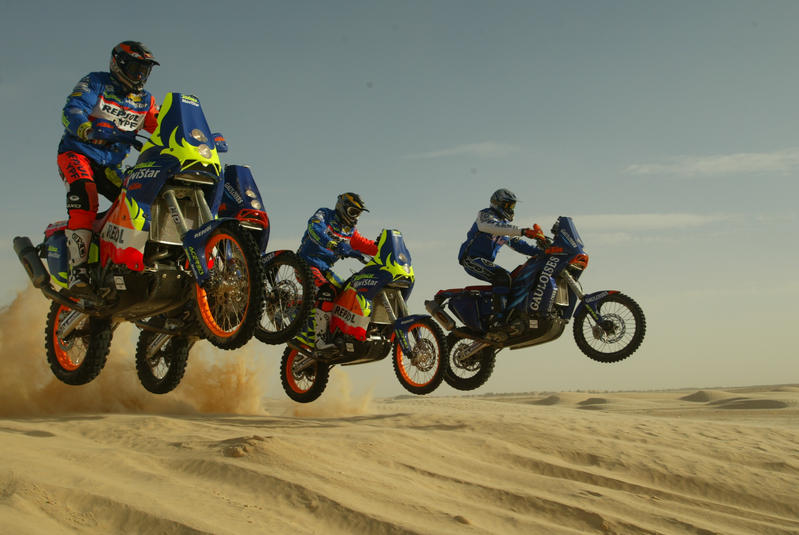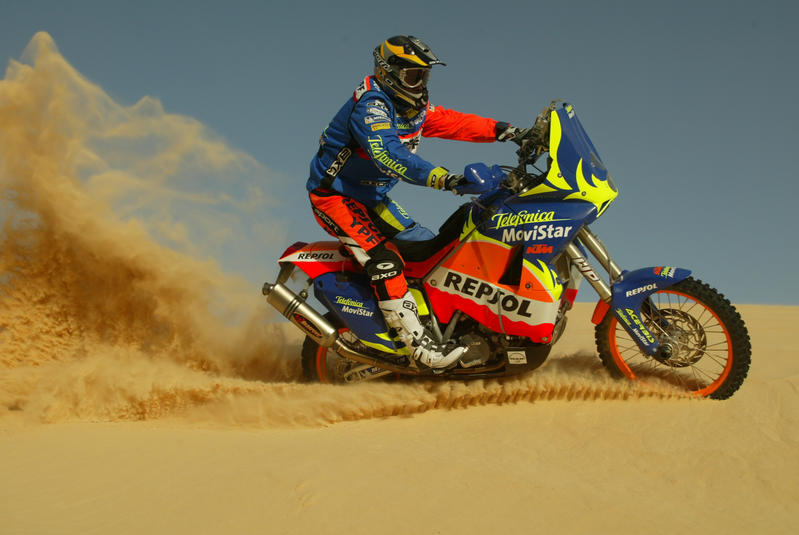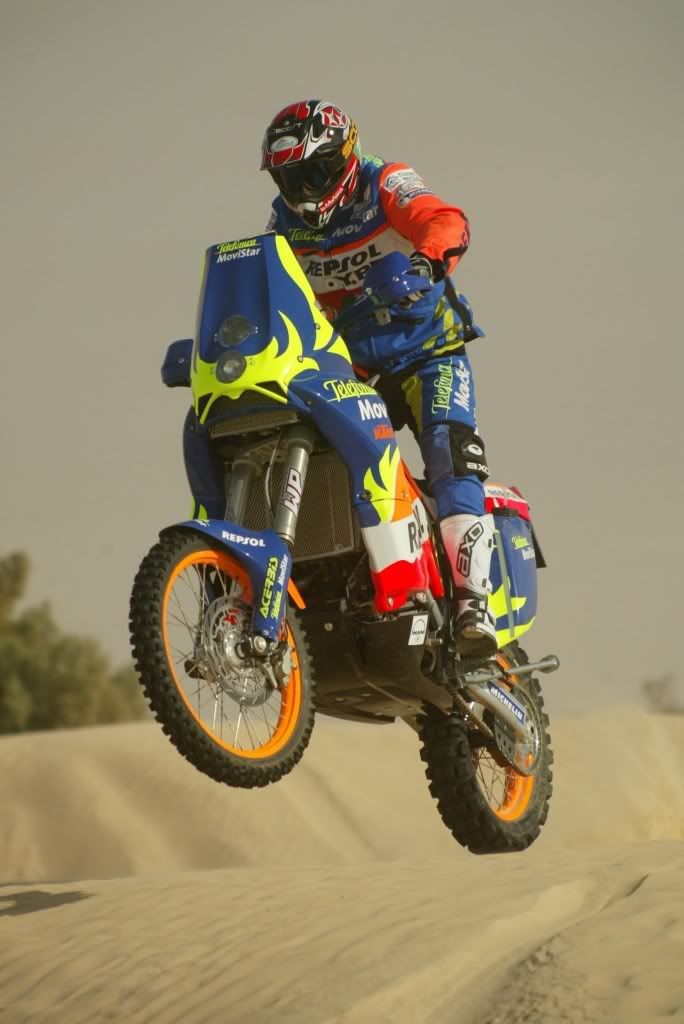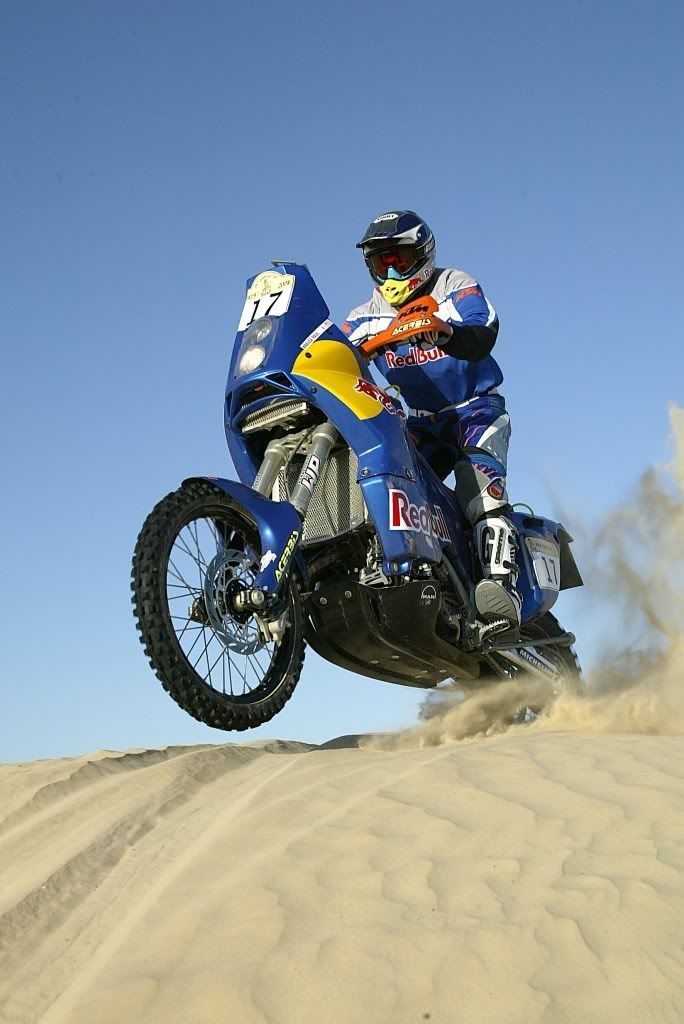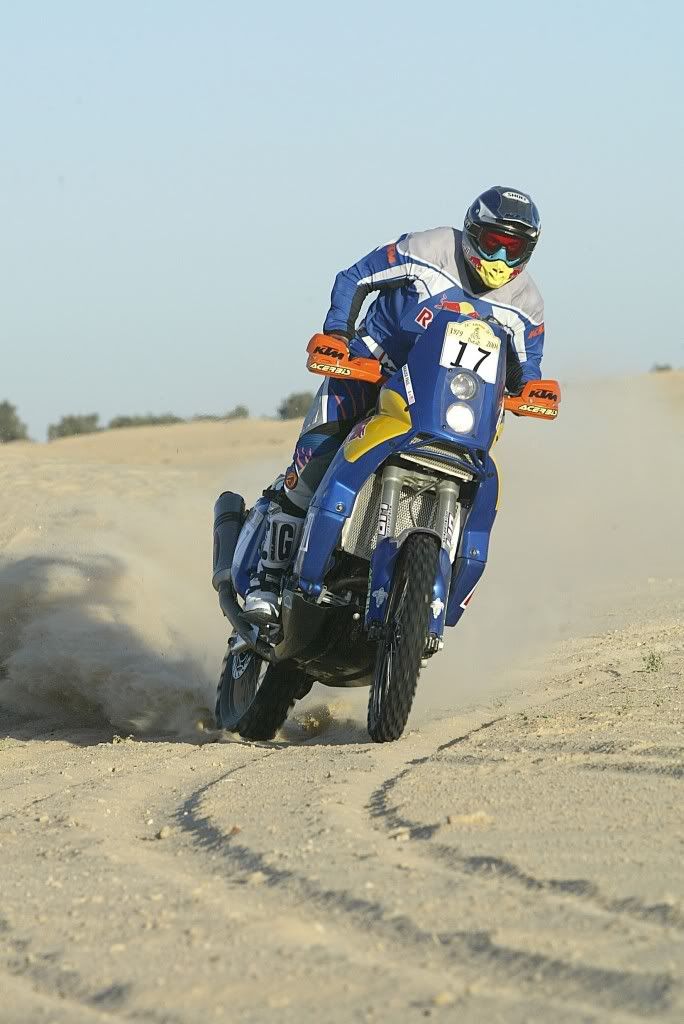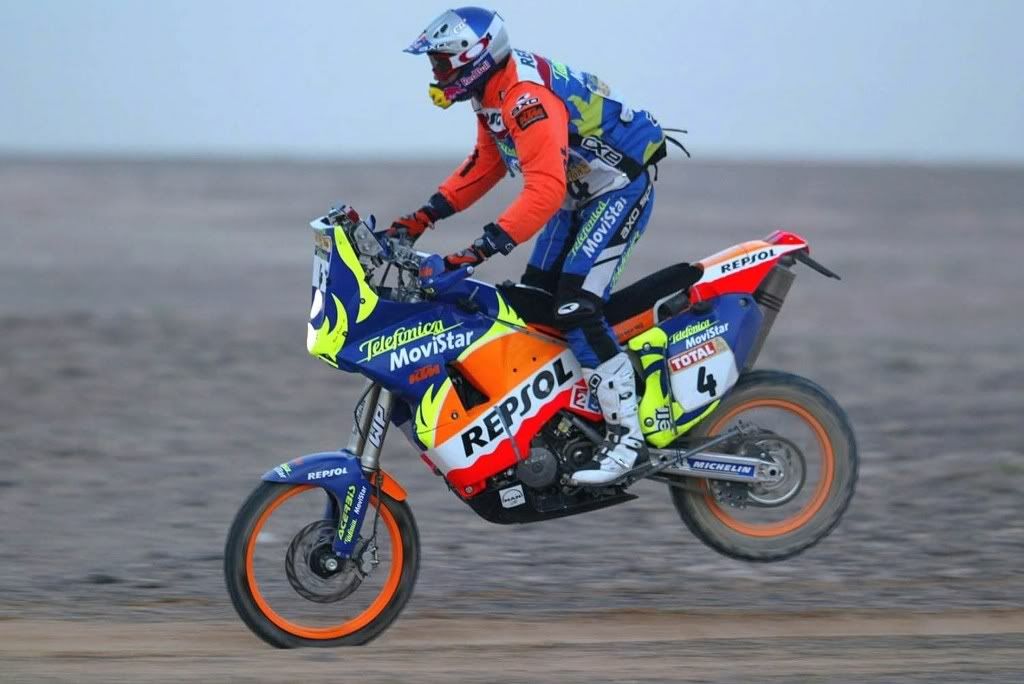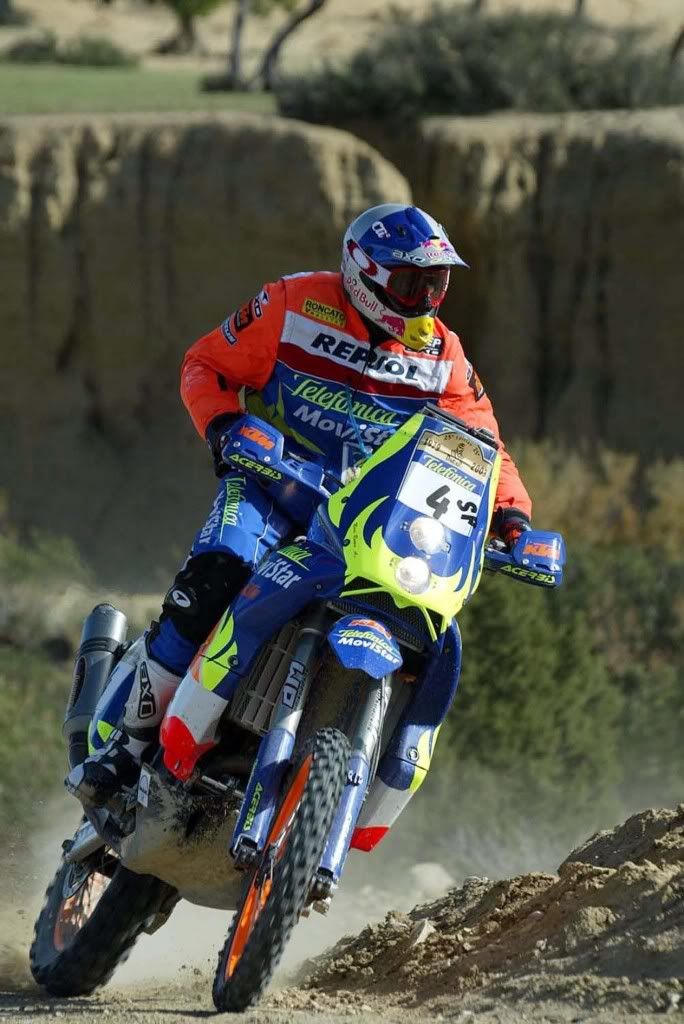KTM 950 Rally NZ 2002
in Reviews. 22 Mar 2006. 835 views.
From tarmac to sand. Alan Cathcart faces the ultimate in a slipping, sliding, and bucking works racing monster.
My skills in sand have hitherto extended only to building a better sandcastle on the beach at Southend or St.Tropez. So to ask me to play in the desert aboard Fabrizio Meoni's Dakar Rally-winning works KTM 950 Rally racer is quite another thing. This is the off-road equivalent of asking someone who's never ridden on slick tyres to pedal Valentino's factory Honda GP bike around Jerez or Suzuka.
KTM's insisted that I extend a career of testing factory racebikes to include riding the prototype of their LC8 V-twin engined desert sled. This would be a window on the Austrian firm's future world of multi-cylinder motorcycles for street use powered by the same engine. The challenge meant journeying to KTM's southern Tunisian test base in Douz. Here the road runs out, and there's a thousand miles of sand dunes to cross before you see another stretch of tarmac.
In fact, I was joining KTM's works rally team the week after they'd won the Rally Tunisia in the same dominant style as they'd triumphed in Dakar earlier in the year, with Spaniard Nani Roma taking victory in his first race aboard the LC8-powered factory racer.
In my first two-hour stint aboard the KTM I discovered that rally racers need to be incredibly strong and possessed with remarkable stamina. They are likely today's most complete motorcyclists in any form of two-wheeled competition, the equivalent of the likes of Burns and Sainz on four wheels, compared with the Schumachers or Coulthards of the concrete car world. One reason why I felt so shattered after my first two-hour session in the Sahara might well have been the number of times I had to lever the 950 Rally upright onto its wheels, after washing out the front wheel one more time and confirming to myself that falling off in the sand is so much more comfortable, relatively speaking, than doing it on the hard stuff at Assen or Monza. I mean, the whole Sahara Desert is one big runoff area full of kitty litter.
Father of the LC8 engine Claus Holweg may take some pride in that the KTM 950 Rally scales just 192 kg. dry, but that's before taking into account even the fraction of the full 58-litre fuel load spread between four fuel tanks that I was running with. That's six litres more than on a KTM single, thus resulting in a gassed-up weight of around 230 kg. The excessive height of the bike does mean that in deep sand, you have to be either very tall yourself, or be adept at using the throttle adroitly.
Eventually, KTM's other V-twin maestro Giovanni Sala took pity on me, and insisted I clamber aboard his 950 Rally and ride pillion for a 10-minute master class in how to ride the dunes. I might add this was the most frightening single thing I've done on a motorcycle since passengering World Sidecar champion Alain Michel on his GP three-wheeler. The experience must have worked for in my second afternoon expedition, this time on Meoni's actual Dakar-winning bike, I exceeded all my best hopes by not even crashing once. I even learnt how to come to rest more or less controllably aboard a motorcycle with the mega-tall 995mm seat height. This apparently allows riders to see over dunes when standing on the pegs.
So what did I learn about the 75-degree V-twin LC8 motor in the application in which it will make its customer debut this coming September? Well, the engine withstood three months of gruelling desert R&D testing in southern Tunisian and remained reliable for up to 12,000 km of competition use. KTM have seemingly combined two diametrically opposed virtues in a single package, by matching a free-revving appetite for revs with readily available and significant amounts of torque. The result is a refined and responsive motor that's so user-friendly, you'd swear it had to be fuel-injected. But it isn't. Even so, the light-action throttle is extremely responsive, with crisp, controllable pickup that's enough to convince you there's a pair of flatslide carbs at the end of the cables. The fact is the 950 Rally comes fitted with a pair of CV-type 43mm Keihin carbs which are quite small for an engine of this capacity. They do, however, represent a key factor in the engine's crisp pickup and good acceleration from low rpm. But if engine response is this good already, imagine how much better it'll be with fuel injection, as in the Duke streetrod entering production next year.
One clue to how KTM have acheived this responsiveness comes not so much under acceleration, but when you back off the throttle and realise how relatively little inertia the Austrian V-twin has, as expressed through engine braking. This comes from a combination of a low compression ratio and reduced crankshaft mass. Holweg says they can go as high as 13:1 compression in street or Supermotard use, but have backed it off here because of poor fuel quality. There's no tachometer fitted to the bike, so I can't tell you how hard I was revving it. The riders have asked Holweg to give them a gear ratio indicator because the on-board telemetry consistently reveals them holding fourth or fifth gear for long periods of flatout running, in the mistaken belief they were in top, sixth gear. "No chance!" says Claus. "This is not a BMW!" - but he might change his mind if the fuel consumption gets to be more of a problem than it presently is. The gearbox action is really sweet, even if I could only persuade myself to use the bottom four ratios even on faster desert tracks. Since Claus's previous job in motorcycles before he went to Rotax to design the RSV Mille motor, was concocting gearboxes for BMW Boxers, that figures. The boy has a bit of transmission experience.
The 75-degree KTM motor delivers absolutely no undue vibration, in spite of being rigidly mounted in the open-loop frame. There's no doubt this will make an absolutely fantastic streetbike motor, even with some of that monster torque peaking with 97 Nm at just 5200 rpm. Roll-on on tarmac is excellent even in top gear at relatively low engine speeds, denoting the KTM motor's ultra-flexibility. It's evident there's not very much transmission snatch at low speeds, again making it easy to hold a gear in the rough stuff and worry about survival rather than getting the right ratio.
Take it from me, after surviving the Sahara and riding the KTM LC8 in its perhaps esoteric but undoubtedly effective first application, I'm convinced this is the debut of an extremely significant powertrain design, which will set new standards for V-twin engineering which others will have to take very seriously. Can't wait to ride the streetbike version.
KTM'S LC8 V-TWIN ENGINE: Not Like The Others
The Austrian kings of the off-road world have been thinking for most of the past decade about how to expand what until now has been exclusively a single-cylinder dirt-derived model range, into twin-cylinder tarmac territory.
Those plans first found expression shortly after KTM boss Stefan Pierer and his colleagues took over the insolvent company early in 1992, and began the spectacular turnaround. It has seen KTM go from bust to boom in less than a decade. First a one-off special called the Bepono, built by two engineering students for the German Battle of the twins series. The motor was basically a pair of cylinders from a KTM LC4 single on a special crankcase. It was displayed on the KTM stand at the Cologne Show. That was just a teaser.

Early 1998, as the company grew in size and the need to expand its hitherto single-cylinder range with a twin-cylinder product line became a priority, Pierer commissioned KTM's chief engineer Wolfgang Felber to make preliminary studies of twin-cylinder engine formats and vehicle concepts. "Our idea wasn't so much to build a better V-twin, but to develop a versatile twin-cylinder engine concept, which had the potential to be used in off-road bikes as well as on the street, without any compromises in either application," says 39-year old Felber, himself a former 250cc Grand Prix road racer. "In fact, we made studies of several other concepts, including not just many kinds of V-twins but also some that might seem a bit strange, like a horizontal as well as vertical parallel twin, crossways and lengthways. We even tried Boxer motors, and a tandem-twin like the 250 GP bike I used to race! But eventually we concluded that a 75-degree V-twin was the best option, especially in terms of following KTM's established policy of going racing."
Compared to a 90-degree format as practiced by Ducati, Honda and Sukuki, the 75-degree layout offered a more compact layout, which in turn allowed KTM to place the engine wherever they wanted in the chassis, without any compromises. The 60-degree option as preferred by first Harley-Davidson, then Aprilia, presented potential difficulties with inlet design and throttle body location. It's too narrow to get a straight hit at the valves. "We would have needed to instal twin counterbalancers, as Aprilia have done, and this was not acceptable either in terms of power loss or, particularly, weight," says Felber. "But we also wanted to make sure there was no lost space in the engine, and so to meet the demands of what we called our Ôbox measurement', assessing how small a box would be needed to contain the entire engine and throttle bodies. We decided the best solution was to place the electric starter between the cylinders, as well as the balance shaft and water pump, for which we needed more space than on a 60-degree or even a 72-degree V-twin angle like Voxan's. It's only a matter of millimetres - but compare this to an L-twin like a Ducati, and you can see the benefits of focusing on this, in terms of bulk and installation."
By August 1998 the decision was made to go with a 75-degree V-twin design, but with special emphasis on light weight and, especially, compact build. To do so, KTM decided to assume the entire R&D process themselves. They hired Claus Holweg as Project Manager for the LC8, fresh from their Austrian rivals, Rotax, There he had headed up the R&D team which had developed the freshly-launched RSV Mille engine for Aprilia "My work on the Aprilia project was at an end, but I already had many ideas I wanted to put into metal in making a Mark Two V-twin that would be even better," says Holweg. "My goal was to build the smallest, lightest and most powerful V-twin engine ever made, but at the same time to make it as safe as necessary in terms of durability. It was a very exciting engineering challenge." The LC8 engine went from a blank computer screen to its first dyno run on August 11, 1999 in exactly 12 months, A remarkable achievement, even if the first time it fired up was in total darkness, thanks to Austria's coincidental total eclipse of the sun that very same day!
How well KTM's R&D team succeeded in meeting their design targets may be judged by comparing the dry weight of the LC8 motor without carbs/throttle bodies, with that of its various V-twin competitors.
The 75-degree KTM (fitted with a single balance shaft) scales just 56 kg, compared to 68 kg. for the 60-degree Aprilia/Rotax (complete with twin counterbalancers), 73 kg. for both the 90-degree Honda VTR1000 and Suzuki TL1000, 75 kg. for an old-style 90-degree Ducati desmoquattro engine (though 72 kg. for the new Testastretta design), and 76 kg. for the lightest version available of the flat-twin BMW Boxer motor - all with perfect primary balance, so no balance weights. This makes the KTM engine between 17% and 26% lighter than its rivals, achieved moreover without extensive use of magnesium. Add to that the Austrian motor's ultra-compact build (see comparative illustration), and it's hard not to applaud the extent of the R&D team's achievement in creating such an intelligent, rational, stripped-down design. This without compromising reliability, or performance. Winning the 2001 Egypt Rally first time out in the hands of Fabrizio Meoni, in the wake of an arduous 120,000 km. test programme, followed by the new 950 Rally V-twin's dominant victory in the hands of the Italian works rider in the gruelling 2002 Dakar marathon, was proof of that.
Nani Roma's win in the Rally Tunisia his first time out on the new bike, underlined its worth: three out of three ain't bad for an all-new design!
The dry-sump LC8 engine is vertically-split, not only to save weight, but also as the easiest way of arranging the crankshaft and twin gearbox shafts on different planes to reduce the overall length of the engine, R1-style. The three-litre oil tank doubles as the oil radiator, positioned ahead of the front cylinder, with twin oil pumps mounted on a single shaft located beneath the multiplate oil-bath clutch.
A wet-sump engine design was never considered, because of the 10 cm. reduction in ground clearance this would entail, unacceptable for off-road applications. In any case, the oil supply to the engine is maintained when the bike is lying on the ground and the engine running - even more important when the rider is, er, prone to error on the Sahara sand! The twin dohc four-valve cylinders are evenly located on the crankcase, not rotated as on a Honda or Suzuki V-twin: "I did a lot of experimentation with wheel clearance and weight distribution," says Felber, "and it turned out this format allows 300mm of front wheel travel on the Rally bike, as well as an ideal configuration for the oil tank, radiator, everything.
But we also looked from the beginning at a street application, and on the Duke with shorter forks, less travel and a 17-inch front wheel instead of a 21-inch one on the off-road bike, we were able to shorten the frame and improve front end weight bias, as well as lowering the centre of gravity by placing the battery in the lost space in front of the engine, all without compromising wheel clearance."
The LC8 uses a forged, one-piece plain-bearing crankshaft, weighing less than 5 kg. This is lighter than one from KTM's own LC4 single, and more than 3 kg. less than a Suzuki TL1000 bottom end, for example.
There are small, semi-circular flywheels, and short H-section forged steel conrods measuring 125mm in length and mounted on a common crankpin. These carry three-ring Mahle pistons which once again are forged, and weigh 378 grams each without bolts. They deliver 11.5:1 compression, and have a flat top and short skirt. Total height of the piston is just 46mm. "For sure we lose a little by having such a light crank," admits Felber, "but from the beginning we tried to create a very responsive engine for sports bike application. It doesn't matter whether it's a road bike or off-road bike, it's the same. Due to the fact we have a very short stroke and very small crankshaft, we put a lot of effort into ensuring it ran smoothly and had good torque at low rpm. We use the same-size flywheels on the off-road carburettor version as on the fuel-injected roadbike version." The crank carries a spur gear on the left side driving the multi-purpose layshaft positioned between the cylinders. This five-function design is typical of the refined rationality of the LC8's design. Thus, it not only carries the twin opposed counterbalancer weights needed to eliminate the primary vibration endemic in a 75-degree V-twin, it also drives the water pump and centrifugal engine breather, as well as acting as an idler wheel for the starter motor, and the composite chain and gear drive to the twin overhead camshafts. A six-speed transmission with gear primary drive is employed on all versions of the LC8.
Unlike on the Bepono project bike a decade ago, the LC8 employs all-new four-valve cylinder heads rather than a pair of those from KTM's existing singles, fitted with bucket tappets and steel valves (38mm inlet and 33mm exhausts), each with double valve springs and sitting at a total included angle of just 22 degrees - very flat, in accordance with best Formula 1 principles. Viewed from above, the steep downdraught and knife-edged divisions of the intake ports is really noticeable, giving a very straight hit at the inlet valves.

"Our main target for design of the cylinder heads was always to maximise compactness by having the smallest possible drive gears on the camshafts, as well as a camdrive mechanism capable of very high revs," says Felber. "We wanted to avoid having the very large camwheels needed to achieve a 2:1 ratio with direct chain drive, like on a Honda Varadero." For this reason, the LC8 employs very short hydraulically-tensioned offset camchains, driven off sprockets mounted at either end of the multipurpose layshaft. These run to an intermediate gear located in each cylinder head, which in turn drives the two small camwheels at the end of each camshaft. The camdrive layout is broadly similar to that of the Suzuki TL1000, but is far more compact in every direction.
In prototype 950 Rally/Adventure form, as well as the V2 Duke guise in which it will make its tarmac debut at Intermot in September, the LC8 engine measures 100 x 60 mm for a capacity of 942cc, but the design was conceived to accomodate various capacities ranging from 800 to 1000cc. There's room to increase the bore up to 103 mm, for example, making an even shorter-stroke 999cc Superbike version a realistic option. The engine is designed to be capable or producing up to 180 bhp at the crank, says designer Claus Holweg, and to rev up to 12,000 rpm safely. While Meoni's Dakar-winning dirt sled and its 950 Adventure customer clone 43.5 mm Keihin CV carbs and a Denso CDI, with the carbs fitted inside the substantial airbox to liberate extra space under the seat, KTM will use fuel-injection and a fully-mapped engine management system on the V2 Duke. In the first tarmac application, power from the 942cc engine will rise to around 120 bhp at the crankshaft, says Wolfgang Felber, compared to the current output of the carburetted off-road engine of 102 bhp at 7800 rpm.
Though the engine has the swingarm pivoting in the crankcases (as well as in the frame) for extra rigidity, it's not a stressed chassis member. "We didn't want to have this because in off-road use we have controlled deformation of the frame in order to reduce rider fatigue," explains Wolfgang Felber, "and if you use the engine as part of the chassis in such a situation, it risks problems with the base gaskets and cylinder head gaskets, and so on, even maybe cracking the castings unless you make them very strong, and so heavy. The engine increases the torsional stiffness of the frame by around 30%, but it's not a load-carrying component in the frame."
Fair enough - but after seeing the fruits of KTM's efforts so far to build a better twin, and the success of their engineers in making a proven effective package for off-road use, it's hard not to believe that this is a Superbike engine in the making.
The LC8 motor has all the attributes in terms of architecture, weight and potential performance to allow the Austrian firm to produce a 250 GP-sized sportbike weighing well under 180 kg., but with more than 130 bhp available in street guise. Or, there again, they could make a deal with Buell and stick an ultra-modern, ultra-compact eight-valve V-twin engine in the new Firebolt with its correspondingly innovative monocoque chassis design! That would be some package. Might KTM perhaps do something similar themselves, so as to go Superbike racing with the result?[/img]

